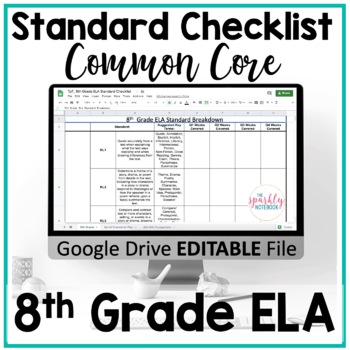Differentiation made easy. Use some of these resources with your gifted students in middle school ELA to keep everyone in the class learning!
One of the hardest parts of teaching students is finding ways to make sure that everyone is learning.
This gets especially hard in middle school when you’re no longer seeing only 25-30 students each day. Now, with numbers up into the hundreds, you still have to make sure that all of your students are moving forward and not staying stagnant.
That means that having processes for differentiation, or resources at different levels of difficulty, are incredibly important.
Today, we’re going to discuss 3 ways you can be prepared to differentiate for gifted students in middle school ELA.

#1 | Using Resources from the Next Grade Level
If you’ve spent any time around middle school standards, then you know that there are very slight differences between the standards at different grade levels. The main difference is often the focus of the activity.
For this reason, using resources for 8th grade with your 7th-graders or 7th-grade resources with your 6th-graders who are more advanced is a very good way to do some quick differentiation.
If you want to examine the standards for each grade level more closely, download our standard-aligned checklists by clicking on the images and links below.



What you’ll see is just how the standards are different and that the resources for the next grade level up could be beneficial.
In The Sparkly Notebook store, we have a bunch of standard-aligned resources for almost all 6th, 7th, and 8th-grade standards, so if there is a specific standard you’re working on with your 7th graders, you can also grab the 8th-grade resource for the same standard and have slightly more difficult resources to use with your advanced students.
#2 | Using Different Reading Passages on the Same Topic
Another way to differentiate for gifted students in middle school ELA is to use passages that are on the same topic as the other students’ passages, but are not the same reading level.
For example, in the store, we have paired passages on the same topic written for different grade levels. Here are the ones we have for Writing Fiction…
- 5th and 6th Grade “Writing Fiction” Bundle
- 6th and 7th Grade “Writing Fiction” Bundle
- 8th and 9th Grade “Writing Fiction” Bundle
- If you’d like to grab all of the passages on this topic, you can even get the WHOLE “Writing Fiction” Bundle here.
#3 | Same Passage, Different Lens
Sometimes, differentiating for gifted students in middle school ELA is about getting them to look at the same piece of writing as everyone else through a different lens.
Since the analysis of writing can change so much depending on the questions being asked or the lens you’re asking students to view the writing through, then simply changing the lens for advanced or gifted students can be enough to challenge them into thinking about a passage in a different way.
For example, your general ed students may look at a passage and try to answer reading comprehension questions about it (as found in the paired passages above). But, your gifted learners may be asked to read the passage with the goal of creating questions that could be asked about it, or they may be reading it with a specific writing prompt in mind.
For example, if the passage is about the positive uses of cell phones in the classroom, then maybe you give your gifted learners the goal of looking at the prompt as if it was written by a cell phone company and how that might change how the passage should be interpreted. How do the sentiments change if the author changes?
Having some go-to strategies for differentiating and even finding good product lines that you can pull from to make differentiation easier will make it easier to plan for gifted students in middle school ELA.
Happy Planning!
